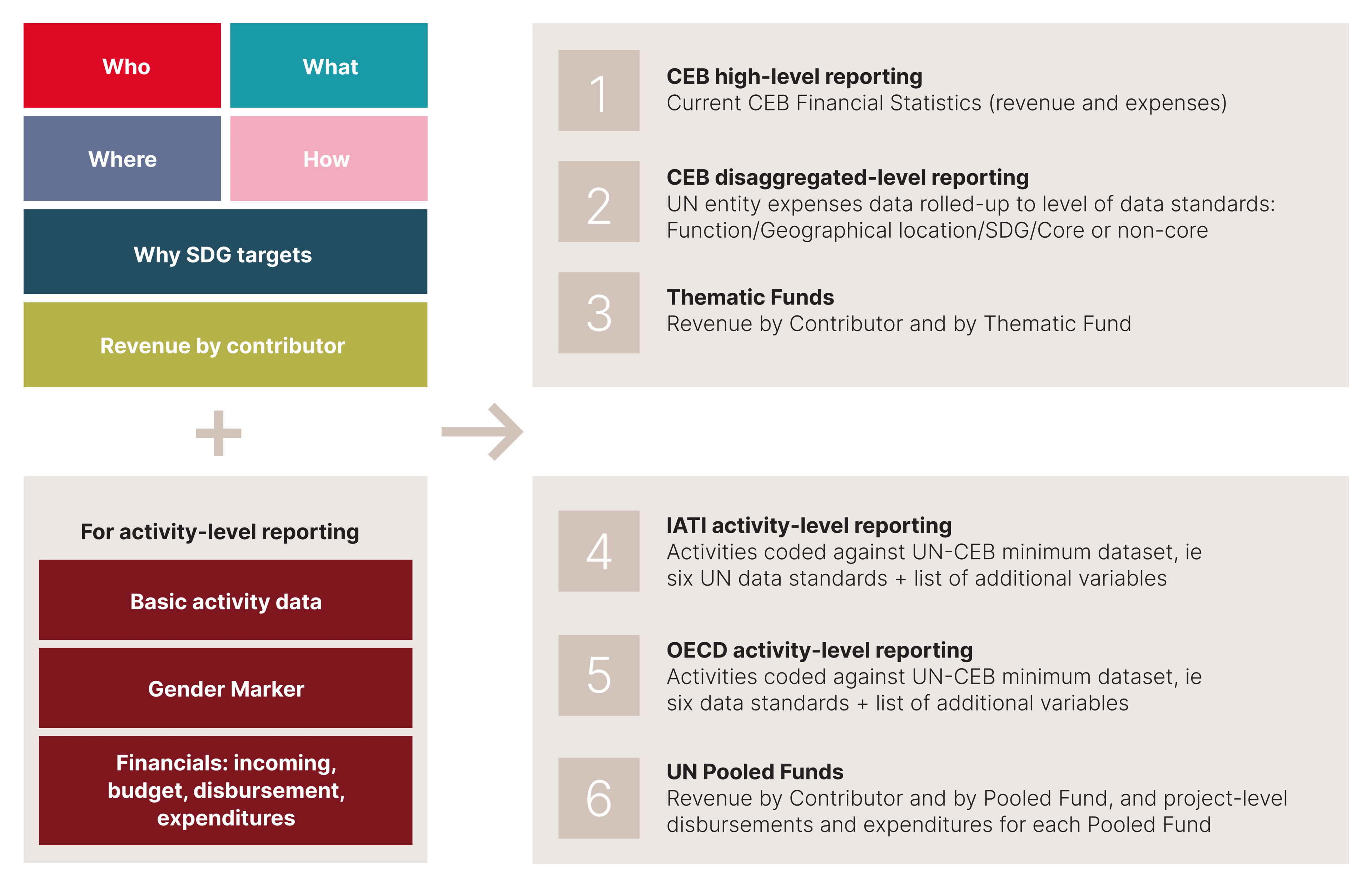Under the chairmanship of the United Nations Secretary-General, the Chief Executives Board (CEB) brings together the Executive Heads of the UN, its 12 funds and programmes, the 15 specialised agencies, and three related organisations. The CEB is a driver of integration and coherence for the UN system in support of Member States. It serves as an internal ‘think-tank’, providing high-level forward-looking solutions in response to mandates from the legislative and governing bodies of its 31 member entities. The CEB, together with its High-Level Committee on Programmes and High-Level Committee on Management, strives to foster systemic transformation through stronger performance and results orientation; better data, analysis and communications; innovation and digital transformation; strategic foresight; and a work culture that reduces unnecessary bureaucracy and amplifies collaboration. The CEB is supported by its secretariat, co-located in New York and Geneva.
Introduction
The Chief Executives Board (CEB) Secretariat is the United Nations inter-agency entity responsible for supporting the work of the CEB and is the UN system’s highest-level coordination forum in the areas of programme and management. Under the umbrella of the CEB’s High-Level Committee on Programmes and High-Level Committee on Management (HLCM) sits the Finance and Budget Network (FBN), composed of the UN system organisations’ chief financial officers. The FBN entities report their revenue, expense and budget data to the CEB Secretariat on an annual basis.
The UN Data Cube, a joint initiative of the CEB’s HLCM and the UN Sustainable Development Group, is one of the three strategic data initiatives recognised in the 2020 Data Strategy of the Secretary-General for Action by Everyone, Everywhere with Insight, Impact and Integrity.1 Established in 2018, the Data Standards for UN system-wide reporting of financial data were the first major result of the UN Data Cube initiative. Its long-term goals were to improve the quality of financial data reported to the CEB and ensure the UN has timely, reliable, verifiable and comparable system-wide and entity-level financial data aligned with the Sustainable Development Goals (SDGs), in order to ‘make better decisions and deliver stronger support to those we serve’.
The Data Cube initiative’s central component during the period 2017–2021 was the roadmap for implementation of the Data Standards, with specific actions broken down into four phases that refined the Data Standards, improved data quality and promoted publication of the resulting datasets. The tagline ‘maximising transparency and minimising effort’ was established as the overarching common thread running through the activities included in the roadmap.
Overall efforts to maximise transparency enabled working towards ensuring the availability of quality UN system-wide financial data for users, both on the CEB website and other data platforms. Partnerships with the International Aid Transparency Initiative (IATI) and the Organisation for Economic Cooperation and Development (OECD) looked at how coverage of UN reporting on the platforms of these two organisations could be improved. One important achievement was harmonisation of UN code lists for the UN Data Standards with the relevant code lists at IATI and OECD, thereby ensuring compatibility. A copy of these code lists were published on the CEB website in early 2023.2
In addition, the Data Cube initiative’s focus remained on minimising efforts and reducing the reporting burden of UN entities. A key achievement in this respect was agreement on a UN CEB minimum dataset that, alongside the harmonised code lists, would enable UN entities to (re)use the same dataset in reporting their data to the CEB, IATI and OECD.
Figure 1: Background of the Data Cube strategy 2022–2025
Source: Chief Executives Board (CEB)
In December 2021, the FBN approved the UN Data Cube strategy 2022–2025, aimed at taking the Data Cube initiative to the next level. The ultimate ambition set out in this strategy is to ensure a fully-fledged UN system-wide Data Cube, with disaggregated financial data for each SDG in every country. When this is achieved, stakeholders will have access to a comprehensive overview of what UN system organisations are spending in support of an SDG in a particular geographical location, with the data separated into development, humanitarian, peace and global agenda-related interventions.
At the core of the strategy are six complementary UN system- wide financial data cuts that should be available by 2025, providing UN stakeholders with a transparent, comprehen-sive snapshot of UN system-wide revenue and expenses, enabling better analytics and evidence-based decisions. The strategy strives to leverage the Data Cube’s full potential in support of the Secretary-General’s Data Strategy, the Quadrennial Comprehensive Policy Review, the Funding Compact and the Grand Bargain, and, ultimately, the 2030 Agenda and Our Common Future.
Figure 2 illustrates the elements underpinning the strategy. Each UN entity will construct a master dataset incorporating all the variables included in the UN CEB minimum dataset (on the left side of the figure). From there, the UN entity can slice-and-dice this master dataset to produce the data necessary to report on each of the six data cuts on the right-hand side of the figure.
Figure 2: Background of the Data Cube strategy 2022–2025
Source: Chief Executives Board (CEB)
Implementation of year one of the Data Cube strategy 2022–2025
The Data Cube strategy 2022–2025 builds upon the incremental successes achieved in 2017–2021 to reflect a holistic, forward-looking perspective on UN system-wide financial reporting. This is reflected in the following achievements seen in its first year of implementation:
Continuous learning and improvement: Feedback received from UN entities and data users in 2022, alongside the results of ongoing monitoring of CEB financial data, are reflected in the annual update of the UN Data Standards, including updated code lists and guidance, as well as the expansion of UN system financial datasets published on the CEB website.
In addition, progress was made in addressing commitment 13 of the 2019 Funding Compact, which calls for improved comparability of cost classifications and definitions, with a plan to introduce reporting of expenditure for enabling functions. To facilitate data analysis, an annual Excel code list was also prepared, bringing together the code lists available in portable document format (PDF) in the UN Data Standards, the code lists used by the CEB for reporting, and cross-walks between the CEB code lists and code lists used by IATI and OECD.
A new data standard: In November 2022 another mile-stone was reached, with the FBN approving a seventh data standard on the UN Gender Equality Marker (GEM) to be used for activity-level reporting to OECD and IATI. UN Women and the CEB Secretariat collaborated on formulating the GEM standard, as well as user guidance and frequently asked questions, after due consultation with both the relevant UN system gender focal points and the FBN’s Task Force on Accounting Standards.
Enhanced monitoring of CEB financial data: In early 2023, a monitoring tool was developed to measure and track progress in implementation of the Data Cube strategy. The tool will assist the CEB Secretariat in providing feedback to UN entities on their areas of progress and areas that still need improvement, including reporting on overall progress against the Data Cube initiative. The first round of monitoring results, compiled in early 2023, shows the tremendous advances made since 2018 in the comprehensiveness and quality of reporting by UN entities, while highlighting areas to prioritise for future improvements. Some highlights of the results are provided in Box 6.
UN pooled funds: Continued collaboration with the UN Multi-Partner Trust Fund Office (MPTFO) focused on enhancing the timeliness and quality of data on UN inter-agency pooled funds. The planned next step is to publish pooled fund data on the CEB website once preliminary work has been done to ensure that the risk of double-counting revenue is minimised (and appropriately communicated). This will ensure that UN Member States will have a single place where they can find data on their total contributions to the UN system, through both direct contributions to UN entities and contributions to UN pooled funds.
Thematic funds: Disaggregated thematic fund revenue data was fully integrated in the CEB’s annual data collection exercise, with thematic funds also classified according to UN function. UN entities responded positively to this further streamlining of reporting procedures and the detailed feedback provided on the quality of data submitted, with a list of thematic funds and their 2021 revenue posted on the CEB website for the first time in late 2022.
Improved access to data for data users: The CEB Secre-tariat took measures to enhance the CEB website as the central place for Member States and other data users to find UN system-wide financial data. Disaggregated data on funding flows at entity and system-wide level can be accessed on the CEB website in a user-friendly format, with visualisations and the option of downloading datasets in Excel and comma-separated values (CSV) formats.3 Ad hoc feedback from a wide variety of data users, including UN Member States, data partners (OECD-Development Assistance Committee (DAC) and the UN Department of Economic and Social Affairs) and think tanks, indicates that data users find it easy to navigate the CEB website and locate the data they need.
Areas for continued focus and improvement
In 2023, the CEB Secretariat will work towards making further progress in achieving the objectives of the Data Cube strategy, including:
- monitoring implementation of the UN CEB minimum dataset, including developments in IATI and OECD-DAC reporting, to identify any action required to ensure that datasets remain compatible between the CEB, IATI and OECD;
- considering adjustments to the existing CEB data platform with a view to introducing disaggregated-level CEB reporting with far more granular data on UN system-wide expenses. The consolidated UN system-wide disaggregated data would show how much each UN entity and the UN system as a whole spends on each function, in each geographical location and against each SDG target, as well as what source of funding is used. This will enable in-depth data analysis not possible with the current highly aggregated data;
- advancing a common methodology for determining the top financial contributors to the UN system, in collaboration with the UN Peace Building Support Office and MPTFO; and
- continuing to foster strategic partnership opportunities between the CEB Secretariat and the OECD, IATI, MPTFO and other important partners.
Looking ahead to the next years of the strategy
Tremendous progress has been made in the comprehen-siveness and quality of reporting by UN entities since the introduction of the UN Data Standards. The continued improvements are an example of impactful collaboration across the whole UN system. As the Data Standards have become more mainstreamed, the CEB Secretariat has started to shift some focus towards more strategic goals that balance the needs of different stakeholders, such as data reporters, users and partners.
This overall progress has, however, not been without its challenges. The CEB Secretariat recognises that the reporting burden for entities is not insignificant, and reporting ‘fatigue’ is at the forefront of its mind when planning for further advancements in the Data Cube strategy. Other challenges exist with respect to accounting standards and reporting on an accrual versus a budget basis (see Box 1 on page 45).
Finally, when it comes to delivering on expected results, there is the challenge of securing sufficient human and financial resource capacity within the CEB Secretariat to provide the necessary strategic leadership and technical support for implementation and management of the Data Cube strategy. The ambitions of the Data Cube strategy can only be fully realised if adequate additional resources continue to be made available for implementing the next three years of the strategy.
Endnotes
United Nations, ‘Data Strategy of the Secretary-General for Action by Everyone, Everywhere with Insight, Impact and Integrity, 2020–22’, May 2020, www.un.org/en/content/datastrategy/images/pdf/UN_SG_Data-Strategy.pdf.
UN, ‘Code lists for UN system-wide reporting of financial data’, 2022, https://unsceb.org/sites/default/files/2023-03/Code%20lists%20for%20UN%….
UN System Chief Executives Board for Coordination (CEB), ‘Financial Statistics’, https://unsceb.org/financial-(2023)statistics.
CEB, ‘Data for download’, https://unsceb.org/data-download.


